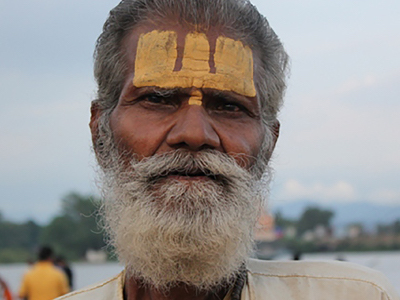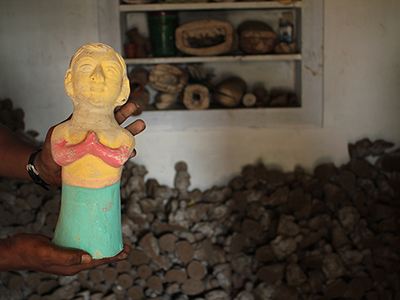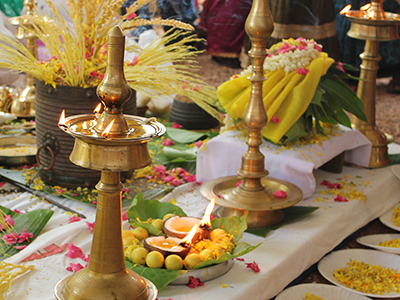
NARRATIVES
"ONE PHOTO, ONE PHOTO!"
North India
I arrived in Bhenswara in the late afternoon, when the light softens and people leave the torpor of their inner courtyards to fill up the streets and sidewalks. Old men have gathered near the blue stall, which is standing high on two bikes and is now anchored in the village square. My imagination pictures the extraordinary vehicle, the owner on top, rushing away at full speed to be on time for its daily duty.
The ritual of the afternoon tea is about to take place. Filtered a few times under the attentive eyes of both shopkeeper and client, the bitter energy drink is sweetened by a generous dose of milk, spices and castor sugar. Here we call it ‘masala chai.’
I prefer mine black and drink it avidly, remembering the advice of a father brought up in the desert: “Tea is the most thirst-quenching of all”. The villagers, standing, sitting or squatting down, take their time for this ultimate afternoon pleasure. Sip by sip, they wake up and rest. They smoke the weariness of the day away.
Walking to the upper temple, I pass by solid Jain houses in pale pink, blue or green, with recurrent patterns of iron gates reminiscent of Art Deco. Doors and shutters sealed, the owners have left for Bombay or Bangalore, where they now carry on their business. They do not sell their houses. Sometimes, they come back for holidays, bringing life back to the main street. The wealth of this little village, lost between the mountains, takes me by surprise. Solid and clean two-storey houses invite me inside, proud to show me a succession of rooms for the cooking, stitching and laundry.
Most children who come to me master a few words of English. They show me around and look at my camera with excitement. A young teenage girl introduces me to her parents and grandparents. She studied at an English school. Now, she wants to be a fashion designer and hopes to carry on her schooling in Jodhpur or Udaipur in the future.
I am her guest. A group of elder men that I photograph from afar invite me to sit with them for a few minutes. The same happens in a temple that welcomes me with open arms. As we walk towards the shepherds’ houses, fingers point at a man in his fifties, ‘the music man.’ His beautiful features remind me of those of jazzmen from New Orleans, and his voice, flying through Rajasthan’s past and traditions, takes me away.
The children, my companions in the village, stop squabbling and listen carefully. We have been chosen to witness grace in its purest form. As I leave the sanctuary of the music man, a shepherd woman, eight months pregnant, comes to me.
She shows me her silver jewellery and bright pink fabric with pride; she makes the numerous white bracelets that cover her arms tinkle. She points at my arms, my ears, and my neck, and she laughs; to her, I appear fully naked. She wants to show me her elder child, a three-year-old boy in a turquoise suit wearing beautiful ornaments, but the toddler bursts into tears. It is either the first time he has seen a white woman or the awakening from a delightful afternoon nap that makes him cry.
We depart with laughs and a friendly namaskar. A bunch of children surround me. One named Gopal, with a cute face and a salmon-pink shirt, repeats ‘One photo! One photo!’ I hide the heavy camera in my handbag and exclaim: ‘nahi camera, nahi’. Then, I have an idea. If photos are a game for them, why not find something that amuses me too? My arms mimic to my young companion the movements of a runner. Gopal stares at me, confused. As I start to sprint, he pauses for a minute, then understands and sprints after me. I pull ahead of him and prance as I reach the finishing line.
We continue wandering in the village and I do not hear another word about the camera. But now and then, children exchange a knowing glance. Staring at me, they mimic the arms of a runner, ready to thrust at any time to follow me. Adults do not see this innocent game. I expect to take control of my body again. Racing the children and sweating profusely, I feel free. Small but cheerful victories are those won with the little ones.

Holy Dust
In her cosy New England kitchen, my grandmother is serving me a cup of green tea. She then sits in front of me, staring. Finally, she asks
Narrative • North India

The House of Toys
In Vilachery, near Madurai, all come to find an icon, an idol, a doll, a toy...
Narrative • Tamil Nadu

An Old-World Luminescence
Get a glimpse of the unique cuisine of the Parsi community, documented through the waning Parsi cafes that were once an integral part...
Behind-The-Scenes • West India

Daughter of the Mountains
A journey along the cities of the Indo-Gangetic Plains exploring the ways of life of its people as shaped by the river Ganges...
Bespoke Journey • North India

Fateh Garh
A luxury boutique hotel perched on the edge of the Aravalli hills that run through the city of lakes...
Hotel Guide • North India

Unified by Fire
The thin line between private and public can be almost invisible in India as compared to other places in the world...


